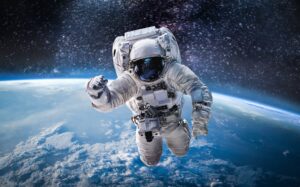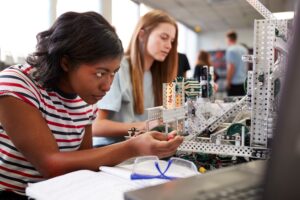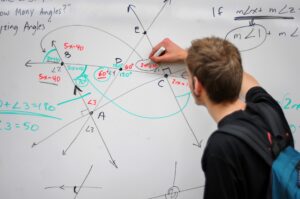
The first NASA astronauts were talented and brave U.S. Air Force test pilots. While there is still a need for astronauts with test pilot backgrounds, most of today’s astronauts are engineers, mathematicians and scientists. Here are the educational requirements to apply to be a NASA astronaut today.
How much schooling does an astronaut need?
Applicants to NASA’s astronaut candidate program must have a master’s degree in a STEM (Science, Technology, Engineering, Mathematics) field from an accredited institution. Degrees include engineering, biological science, physical science, mathematics or computer science.
Engineering
Engineering is the application of scientific processes to design or develop structures, machines or processes. There are different types or schools of engineering, all of which have applications for the work of an astronaut.

- Aerospace engineering focuses on designing, building and testing aircraft and spacecraft. Holders of this degree have a proven understanding of aerodynamics, general engineering principles, propulsion and mechanics—all of which they’ll need working aboard a spacecraft or space station.
- Mechanical engineering involves researching, designing, testing, developing, building and testing mechanical devices (engines, tools, sensors, machines and mechanical systems). Areas of study include mechanics, dynamics and thermodynamics, materials science, structural analysis, engineering physics and electricity. This versatile skill set will serve an astronaut well in space and on land.
- Electrical engineering focuses on the design, development, testing and maintenance of electrical systems and equipment. Astronauts can use the skills obtained with this degree to work with radar and navigation systems, automation controls, communications systems, instrument panels and more.
Biological Science
Biology is the study of living organisms. Much of our work in space exploration concerns the possibility of life on other planets, and the potential for human beings to survive and thrive in places other than Earth. Astronauts with a biological science degree can research and find ways to sustain life even in challenging environments.
Physical Science
Physical science is the study of non-living things, and how they affect the world around us. This subject can include a variety of specified studies of science like chemistry or physics, even astronomy. The study of physical science can provide insight into the universe, planets, and space and understand how these elements come together.
Mathematics

A degree in mathematics helps prepare astronaut candidates for finding solutions and solving the real-world problems they will encounter. Whether piloting a spacecraft, repairing equipment or conducting research and experiments, mathematics is part of the daily life of any astronaut.
Computer Science
Computer science is the study of computers, their theoretical and algorithmic foundations, and how they process information. Astronauts with this degree understand how computing can be applied to solve problems, and will also have practical knowledge of how the complex automation and computing systems used in space work.
Are there exceptions to the master’s degree requirement for NASA astronauts?
There are currently three ways to meet the educational requirements for NASA astronauts other than the STEM master’s degree:
- Two years of work towards a doctoral program in a related STEM field
- A completed Doctor of Medicine (M.D.) or Doctor of Osteopathic Medicine (D.O.) degree
- Completion of a nationally recognized test pilot school program
Are there previous work requirements to apply to be a NASA astronaut?
All astronaut candidates must have at least two years of related professional experience after they complete their degree. Or, they can have at least 1,000 hours pilot-in-command time on jet aircraft. These requirements prepare future astronauts for hands-on work with spacecraft and research.
What are the physical requirements to be an astronaut?
Just like pilots, astronaut candidates must have 20/20 vision, either naturally or with corrective lenses. They must have a healthy blood pressure level, not exceeding 140/90, to withstand the effects of microgravity on blood distribution in the body. According to NASA, candidates must have a height between 62 and 75 inches or 157.48 to 190.5 centimeters. Astronauts need to be tall enough to reach controls but not so tall that the suit or area onboard a spacecraft or the space station is too cramped.
Astronaut candidates must also be in peak physical condition to pass the NASA long-duration flight astronaut physical. Astronaut training takes place over two years and is famously grueling. Trainees are exposed to the atmospheric changes they will experience in space multiple times a day to acclimate them to these conditions. They train in antigravity chambers and in water, where trainees are required to swim and tread water wearing heavy space suits.
How can young people start working toward being an astronaut?
NASA provides many resources for young people who aspire to be astronauts, including a checklist for students. It’s a great place to start.
Center for Innovation and Education can help students interested in space careers with exciting educational and volunteer opportunities. Check out our Audience With an Astronaut series, Cadet Space Explorer Program, Space Foundation Discovery Center Junior Docent volunteer program, and much more.
